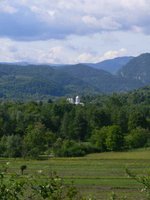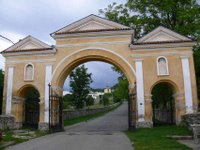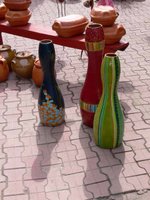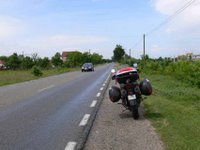
With the sunsetting, we rode into the small town of Horezu. Horezu is best known for its beautiful pottery and the Brancoveanu monastery which is listed as an UNESCO World Heritage site.
Entering the monastery grounds through
 the carved pearwood doors and ten-pillared porchway, the focal point was the Great Church built in 1693. Indeed, the Western and Oriental architectural style of Brancoveanu can be witnessed here. We learned that the country’s most prestigious fresco painting school was here in the 17th and 18th centuries. On an interesting note, we were departing when two German motorcyclists arrived in search of lodging. The monastery has 20 rooms available for guests.
the carved pearwood doors and ten-pillared porchway, the focal point was the Great Church built in 1693. Indeed, the Western and Oriental architectural style of Brancoveanu can be witnessed here. We learned that the country’s most prestigious fresco painting school was here in the 17th and 18th centuries. On an interesting note, we were departing when two German motorcyclists arrived in search of lodging. The monastery has 20 rooms available for guests. Ten kilometers from Horezu was another Brancoveanu-style structure, the Bistrita Monastery (1856). Until the early 80s, the monastery was home to one of the country’s largest schools for handicapped children.
Ten kilometers from Horezu was another Brancoveanu-style structure, the Bistrita Monastery (1856). Until the early 80s, the monastery was home to one of the country’s largest schools for handicapped children.While wooden furniture and wrought-iron items are made in Horezu, it is
 best known for its pottery.The plates are especially popular with their greys, blues, greens, and burnt yellows. Throughout the region, there are small shops as well as pieces displayed for sale along the roadside in front of homes. Fortunately, we had a bit of space for a few treasures (well wrapped) in the luggage!
best known for its pottery.The plates are especially popular with their greys, blues, greens, and burnt yellows. Throughout the region, there are small shops as well as pieces displayed for sale along the roadside in front of homes. Fortunately, we had a bit of space for a few treasures (well wrapped) in the luggage!After a phone call to a local family listed in our travel book, we arrived at the Draghici Family to spend the evening. We later would learn they had not been taking guests since 2003, but decided to accept us for the evening. Their immediate, gracious hospitality and dinner with appetizer, salad, main entrée and accompanying taste of Moldova wine and homemade cherry liquer was welcomed after a full day’s ride.

To our surprise, the next morning we were greeted with a wonderful breakfast of hard boiled egg, bread, homemade plum jam, butter, and mint tea to ensure plenty of fuel for the long day’s ride ahead of us. – HSR

No comments:
Post a Comment